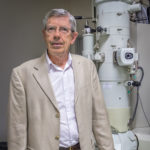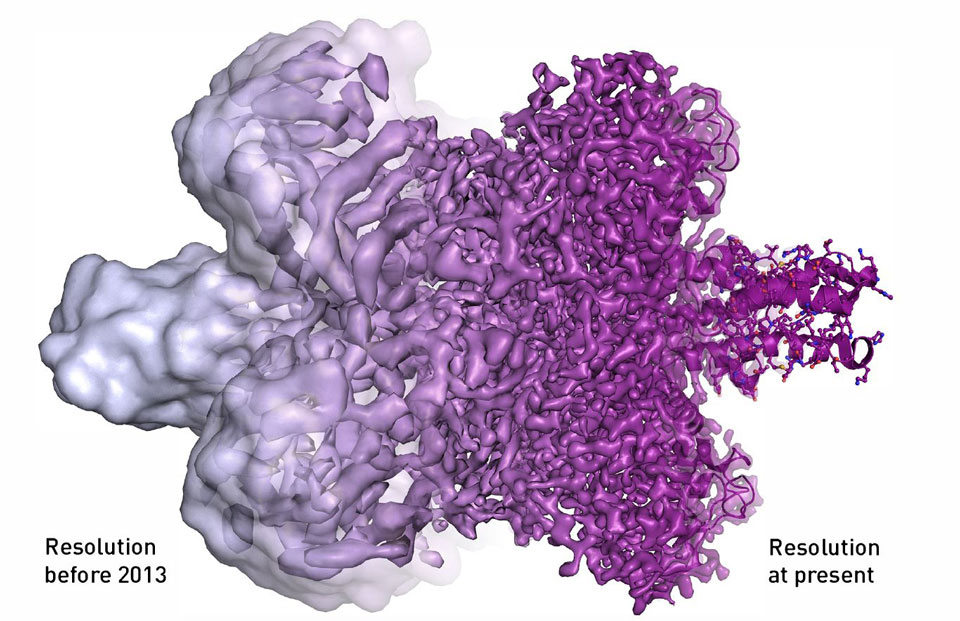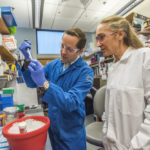Several Berkeley Lab researchers contributed to the foundational work leading to the development of cryo-electron microscopy (cryo-EM), for which Jacques Dubochet, Joachim Frank, and Richard Henderson were awarded the 2017 Nobel Prize in Chemistry. Among those cited in the Scientific Background are Biosciences’ Bob Glaeser, Ken Downing, and Eva Nogales.
 Glaeser, a senior scientist in Molecular Biophysics and Integrated Bioimaging (MBIB) and a UC Berkeley emeritus professor of biochemistry, was an advisor for Nobel winner Joachim Frank when Frank was a postdoctoral researcher at Berkeley in the early 1970s. The Nobel committee noted Glaeser’s research on quantifying electron-induced radiation damage and providing guidance for the use of low-electron doses averaged over multiple samples. In addition, Glaeser showed that cooling samples results in improved resistance to radiation damage, and he developed technical solutions for handling specimens at cryogenic temperatures, making longer exposure times and greater electron intensities possible.
Glaeser, a senior scientist in Molecular Biophysics and Integrated Bioimaging (MBIB) and a UC Berkeley emeritus professor of biochemistry, was an advisor for Nobel winner Joachim Frank when Frank was a postdoctoral researcher at Berkeley in the early 1970s. The Nobel committee noted Glaeser’s research on quantifying electron-induced radiation damage and providing guidance for the use of low-electron doses averaged over multiple samples. In addition, Glaeser showed that cooling samples results in improved resistance to radiation damage, and he developed technical solutions for handling specimens at cryogenic temperatures, making longer exposure times and greater electron intensities possible.
 This laid the foundation for work that would be done by Nobel winner Richard Henderson, who was first author on one of Downing’s papers cited in the section on “Cryo-EM structures at high resolution.” Formerly the head of the Life Science Division’s Structural Biology Department, Downing, a senior scientist in MBIB, developed spot scan imaging, which minimizes beam-induced movement, and dynamic focus correction, which improves clarity. These innovations enabled him to determine the structures of bacteriorhodopsin and the plant light-harvesting complex.
This laid the foundation for work that would be done by Nobel winner Richard Henderson, who was first author on one of Downing’s papers cited in the section on “Cryo-EM structures at high resolution.” Formerly the head of the Life Science Division’s Structural Biology Department, Downing, a senior scientist in MBIB, developed spot scan imaging, which minimizes beam-induced movement, and dynamic focus correction, which improves clarity. These innovations enabled him to determine the structures of bacteriorhodopsin and the plant light-harvesting complex.
Nogales, a senior scientist in MBIB, was a postdoctoral researcher in Downing’s lab. Together they conducted definitive transmission electron microscopy (TEM) work that revealed the atomic structure of tubulin. Their paper was used by the Nobel committee as corroborating evidence for the usefulness of Henderson’s milestone method of achieving atomic resolution structures by averaging over many copies of the same object. Nogales was also interviewed about the prize on NPR’s Here and Now.
“Without their the pioneering work, I’m sure the prize would have still been a few years away,” noted MBIB Division Director Paul Adams, recognizing the contributions of Glaeser, Downing, and Nogales. Read more in the Berkeley Lab News Center.





